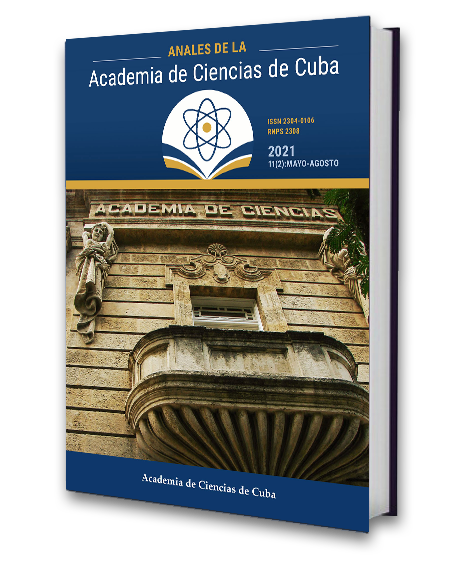Bibliometric analysis and network mapping of international scientific literature by the Cuban Academy of Sciences in Web of Science (1968-1994)
Keywords:
Cuban Academy of Sciences, period 1968-1994, bibliometry, scientific production, collaborative networksAbstract
Objective: The aim of this study is to analyze the scientific production of the Cuban Academy of Sciences (the Academy, in what follows) using bibliometric tools.Methods: We performed a search in Web of Science, involving documents published between 1968 and 1994, a period in which the Academy acted as a multidisciplinary scientific institution with several subordinate research institutes, acting at the same time as the national state agency for science and technology during the years 1980-1994. A total of 726 documents were retrieved. We used bibliometric indicators to explore documents production, dispersion, distribution, and annual growth, as Price's law of scientific literature growth, Lotka's law, the transient index and the Bradford model. We also calculated the participation index of the different countries and institutions. Finally, through bibliometric mapping, we explored the co-occurrence networks for the most frequently used terms in documents of CAC.
Results: A total of 726 documents were retrieved. Scientific production was better adjusted to exponential growth (r = 0.8308) than linear (r = 0.7417). The transience index was 63.74%, which indicates that most of the scientific production is due to very few authors. The signature rate per document was 1.19. The Bradford core is integrated, exclusively, by Cuban Journal of Agricultural Science. USSR (as country) and Cuban Institute of Animal Science (as institution) present the highest ratio of collaboration with the Academy. Map network visualization shows the generated term map detailing on clusters of closely related terms.
Conclusions: The growth of the scientific literature of the Academy was exponential for the period studied, which confirms compliance with Price's law of growth of scientific literature. On the other hand, the transience rate is very high, which indicates the presence of numerous authors who published sporadically with affiliation to the Academy.
Downloads
Downloads
Published
How to Cite
Issue
Section
License
The journal Anales de la Academia de Ciencias de Cuba protects copyright, and operates with a Creative Commons License 4.0 (Creative Commons Attribution-NonCommercial License 4.0). By publishing in it, authors allow themselves to copy, reproduce, distribute, publicly communicate their work and generate derivative works, as long as the original author is cited and acknowledged. They do not allow, however, the use of the original work for commercial or lucrative purposes.
The authors authorize the publication of their writings, retaining the authorship rights, and assigning and transferring to the magazine all the rights protected by the intellectual property laws that govern in Cuba, which imply editing to disseminate the work.
Authors may establish additional agreements for the non-exclusive distribution of the version of the work published in the journal (for example, placing it in an institutional repository or publishing it in a book), with recognition of having been first published in this journal.
To learn more, see https://creativecommons.org






